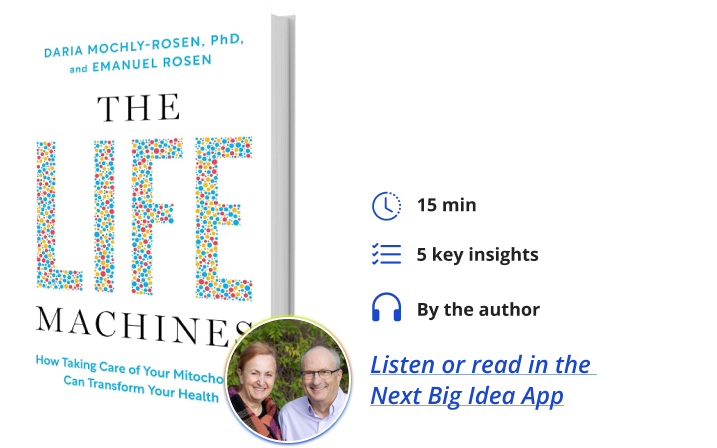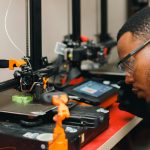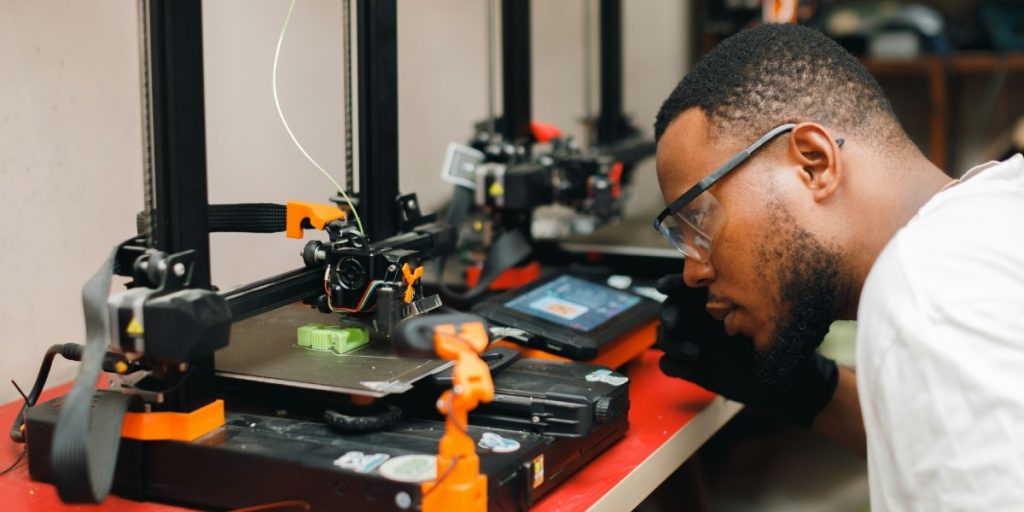Below, co-authors Daria Mochly-Rosen and Emanuel Rosen share five key insights from their new book, The Life Machines: How Taking Care of Your Mitochondria Can Transform Your Health.
Daria is a professor for translational medicine at Stanford University School of Medicine. Based on her discoveries, she has founded three biotech companies. She also founded SPARK, a program that helps academic researchers launch biomedical discoveries into licensing deals, startups, or clinical trials.
Emanuel is the author of the national bestseller The Anatomy of Buzz and the award-winning Absolute Value. He was previously vice president of marketing at Niles Software, where he launched the company’s flagship product, EndNote. He has presented his work at companies such as Google, Intel, and Nike.
What’s the big idea?
Mitochondria are tiny, multitasking life machines that influence everything from energy and immunity to aging and disease. As science uncovers how they communicate across organs and respond to lifestyle choices, taking care of our mitochondria is emerging as a surprisingly powerful way to boost health and improve medical treatments.
Listen to the audio version of this Book Bite—read by Daria—below, or in the Next Big Idea App.

1. Mitochondria are the key to a healthy body.
Mitochondria are amazing nano-machines. As you listen to me right now, tiny rotors are spinning at a rate of hundreds of revolutions per second inside your mitochondria. They’re transferring energy from the food you ate into a molecule called adenosine triphosphate, or ATP, which is then used to power the cell’s activity. ATP is the energy currency of the cell.
Having healthy mitochondria is the key to healthy cells and thus to healthy organs and a healthy body. We are not alone in this belief. Based on remarkable progress in mitochondrial research these past few years, other scientists agree.
Many people refer to mitochondria as “the powerhouse of the cell,” and this is not wrong. These tiny organelles are critical in transferring energy from the food we eat into ATP. But the term, “the powerhouse of the cell” originated years ago when scientists didn’t know much about everything else that mitochondria do.
We now know that mitochondria do much more than energy transfer. They send signals that regulate cell activities. They replenish essential building blocks of the cell. They help our cells fight viruses. They clean cells from toxic metabolites. They kill cells that should die. And these are just some examples of what they do every day throughout our lives. Understanding their wide range of functions will make you appreciate mitochondria’s full impact on your health.
In fact, life as we know it on planet Earth has been made possible by mitochondria. It is believed that one and a half billion years ago, they were an ancient bacteria that became engulfed by early cells. This was the beginning of a beautiful friendship that enabled all complex life forms on planet Earth. And this is why we refer to mitochondria as “the life machines.” They give us life. They can take it away. And when they malfunction, our health deteriorates.
2. Mitochondria in one cell can affect other cells, even in remote organs.
Until recently, scientists believed that mitochondria only influence the cell within which they reside. But new research shows that mitochondria can move out from their original cell or send compounds that affect the function of other cells in remote organs. This means that if we find ways to improve the function of mitochondria in cells in one part of our body, we may be able to improve the functions of other parts.
“Having healthy mitochondria is the key to healthy cells and thus to healthy organs and a healthy body.”
Here are just two examples of this amazing phenomenon. The first example: exercise. Exercise that improves mitochondria in your skeletal muscles can also affect other organs, like your lungs, heart, and brain. The second example comes from my lab: We developed a compound that improves mitochondrial function. When injected under the skin of mice, we were surprised to observe that it also affected their brains. Why? We just don’t know. Yet reports of the same phenomenon, where mitochondrial intervention in one area of the body influences mitochondria in other organs, keep coming.
The fact that mitochondria regulate many important functions and that their influence is not limited to their home cell has profound implications. Taking care of our mitochondria can transform our health.
3. We can take care of our mitochondria by making smart lifestyle choices.
First, exercise. Exercise increases the number of well-functioning mitochondria in your skeletal muscles. This can affect other organs, like your brain. Exercise also stimulates cellular “recycling programs,” a process by which cells break down damaged components and reuse the materials to build new structures.
Another, perhaps surprising, example is increasing your fiber intake. We all know that fiber helps keep you regular, but fiber also feeds the mitochondria in your gut lining cells. The mitochondria in gut lining cells depend on a compound called butyrate to work properly. But our bodies are not very good at extracting butyrate directly from food. Instead, we rely on certain “good” bacteria in our gut that feed on dietary fiber and produce this compound for us. When properly fed, the mitochondria support these gut lining cells that keep dangerous microbes away from our bloodstream. Our end of the deal is to give them enough fiber.
My co-author on this book is my husband, Emanuel Rosen, who is a writer. After I told him about the importance of fiber for mitochondrial function, he started measuring how much fiber we eat every day. Although we have always eaten plenty of fruit and vegetables, measuring our intake showed that we didn’t always meet the general recommendation for daily dietary fiber. By adding half an avocado to our salad, for example, we significantly increase our fiber intake. We’ve also boosted our fiber consumption by eating lentils, beans, and chickpeas more often.
“Our end of the deal is to give them enough fiber.”
Another lifestyle choice to help your mitochondria is getting a good night’s sleep. During the day, mitochondria focus on energy transfer and all their other jobs. During the night, they focus on recovery. Every night, mitochondria perform this essential cleanup. Our job is simple: sleep. Experts recommend going to bed at the same time every night, sleeping in a dark, cool room for seven to nine hours, avoiding blue-light-emitting screens, and, importantly, avoiding anxiety-inducing content right before bed. Emanuel and I learned the hard way that difficult conversations before bedtime don’t lead to a good night’s sleep, so unless it’s urgent, we don’t start tough conversations in the evening.
Avoiding prolonged stress is another important way to take care of our mitochondria. Some stress is inevitable, but some stress we can avoid. For example, we used to watch two to three hours of news every evening—a reliable source of anxiety. We still follow events closely, but have greatly reduced our exposure. This change came after learning more about how emotional stress affects our cells. Under stress, the body directs most of its ATP to urgent tasks while reducing ATP use on maintenance tasks like repairing the cells. When you are always stressed, your body stays in crisis mode, and cell maintenance suffers.
My last example is reducing your exposure to certain harmful agents. Everyone knows that cyanide can be fatal, but have you ever wondered how it can kill someone? It poisons mitochondria. But agents that are harmful to mitochondria can come from less-known sources: alcohol, smoking, vaping, eating processed food, trans fats, fried and barbecued food, exposure to pesticides, UV light, or air pollution. Although mitochondria have means to reduce the damage of such agents, high levels overwhelm the mitochondria.
4. New medical interventions can help take care of your mitochondria.
Given their central role in the life of the cell, it’s no wonder that dysfunction of mitochondria has been linked to diseases and conditions such as Alzheimer’s disease, type 2 diabetes, heart disease, cancer, depression, autism, chronic fatigue syndrome, and even infertility. Now, all the new knowledge about these organelles is starting to be translated into actual solutions. There are currently dozens of clinical trials in this area.
A particularly exciting advancement is mitochondrial transplantation. In certain cases, mitochondria move naturally from healthy cells to help neighboring cells that are in trouble. Now, scientists and physicians are trying to emulate this natural process to treat the heart, brain, and other organs. In this procedure, healthy mitochondria are injected into the patient’s organ or blood vessels, and good results are being reported by cardiologists, neurosurgeons, and other clinicians. Some of these studies (all in early stages) suggest that mitochondrial transplantation may have positive effects across the body.
5. Mitochondria will play a growing role in the future of medicine.
Mitochondria are amazing machines. Mitochondria are also the only organelle (except for the nucleus) that have their own DNA. And did you know that mitochondria participate in the beautiful process of shaping the embryo? The hands of the fetus in the early stages of development first look like mittens, and then a magical process begins. Mitochondria’s role in this process is to be the assassins that ensure the elimination of unnecessary cells between the digits. This is how our fingers are formed.
“Mitochondria are also the only organelle (except for the nucleus) that have their own DNA.”
New research related to mitochondria keeps coming. In recent years, scientists discovered that cancer cells steal mitochondria from the immune cells that come to fight them. Could we inhibit that? Another group of researchers found that mitochondria in human eggs suppress some of their own activity to keep the eggs in pristine condition. Is infertility sometimes related to eggs “forgetting” to switch on their mitochondria? Another research group found some evidence that dreaming at night helps the brain get rid of mitochondrial waste that accumulates in the brain during the day. So, if you want to help your mitochondria, keep dreaming.
All these findings may eventually be used to help patients. I believe that an organelle that plays such a central role and has so many functions in the cell cannot be ignored when it comes to healing the body. Understanding the role of mitochondria in health and disease will shape the future of medicine.
Enjoy our full library of Book Bites—read by the authors!—in the Next Big Idea App:































